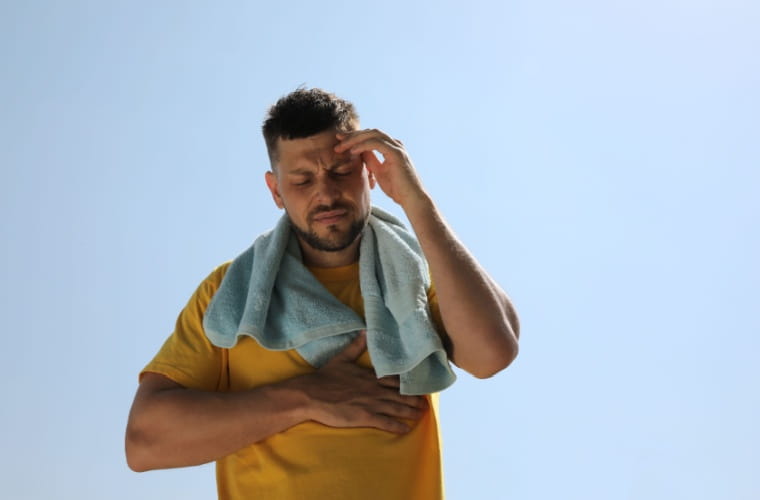Beat the Heat: Signs of Heat Stroke vs. Heat Exhaustion You Can’t Ignore

Summer’s soaring temperatures bring more than just beach days and barbecues—they also increase the risk of serious heat-related illnesses. Each year, thousands suffer from heat exhaustion and heat stroke, conditions that can escalate rapidly if not recognized and treated properly.
“Knowing the difference between these two heat illnesses isn’t just helpful—it can be lifesaving,” warned Dr. Fred H. Brennan Jr., a family medicine and sports medicine physician with BayCare Medical Group.
Dr. Brennan broke down the warning signs, symptoms and crucial action steps you need to remember to protect yourself and your loved ones from the dangers of extreme heat.
What Is Heat Exhaustion?
Heat exhaustion occurs when your body struggles to cool itself, typically after prolonged exposure to high heat combined with physical exertion and dehydration.
“Heat exhaustion often presents with symptoms like heavy sweating, rapid pulse and muscle cramps,” explained Dr. Brennan. “It's your body's way of warning you to cool down and hydrate.”
Additional symptoms may include:
- Fatigue and weakness
- Flushed or pale skin
- Nausea or dizziness
- Headache and faintness
- Muscle cramps
During heat exhaustion, the core body temperature usually stays below 104°F.
What to do:
- Move to a cooler or shaded area
- Drink water or an electrolyte drink
- Rest and remove any excess clothing
- Apply a cool, moist face towel to your face or use a fan to cool down
“Moving to a cooler environment, drinking fluids and resting can help,” advised Dr. Brennan.
What Is Heat Stroke?
Heat stroke is a serious, potentially life-threatening condition that happens when the body can no longer regulate its temperature.
“Heat stroke is a medical emergency,” said Dr. Brennan. “It’s characterized by a body temperature above 103°F, along with confusion, nausea and even unconsciousness. Think of this as a ‘heat attack.’.”
Warning signs include:
- Hot, dry or red skin (lack of sweating)
- Confusion or strange behavior
- Slurred speech or disorientation
- Seizures or loss of consciousness
- Rapid, shallow breathing
- Unsteady walking that resembles intoxication
“The biggest thing is mental status changes,” warned Dr. Brennan. “If someone starts acting oddly, running awkwardly or seems confused—that's an emergency.”
If you suspect heat stroke, act FAST:
- Call 911 immediately
- Move the person to shade or air conditioning
- Remove excess clothing
- Begin cooling with fans, ice packs or wet cloths
- Stay with the person until help arrives
“Get them out of the direct sun and start the cooling process—fan them, pour cold water on them, put ice over the head,” said Dr. Brennan.
How to Prevent Heat-Related Illness
Dr. Brennan shares simple but essential tips to help prevent overheating in the first place:
- Acclimate slowly. Start off slowly—just 20 to 25 minutes outside during the first two weeks. Then gradually increase your time outdoors by 20-30 minutes.
- Time your activity wisely. Exercise early in the morning or about 45 minutes before sunset when temperatures are cooler. Keep air quality in mind- minimize outdoor exercise when air quality is poor.
- Dress smartly. Wear light-colored, breathable fabrics, a hat and sunscreen.
- Hydrate often. Drink water every 5 to 10 minutes. If you're out for more than an hour, add sodium or electrolytes. like a sports drink. Remember: if you're thirsty, you may already be getting dehydrated, and heavy sweaters need to drink even more to replace lost fluids.
- Listen to your body. Humidity can sneak up on you. If something feels off, move indoors where it’s air-conditioned.
Recognizing the symptoms of heat exhaustion and heat stroke—and knowing how to respond—can save lives. Whether you're hitting the trail, mowing the lawn or cheering on a summer sports game, remember to:
- Stay hydrated
- Take breaks
- Avoid the midday sun
- Watch for warning signs
“Even young, healthy people are vulnerable,” said Dr. Brennan. “Respect the heat, and you’ll stay safe in it.”
For a deeper dive into how to stay safe while staying active in the heat, tune into Dr. Fred Brennan’s full podcast episode, “Exercising Safely in the Heat.” You can also find more wellness-focused podcasts on the BayCare HealthChat website.
